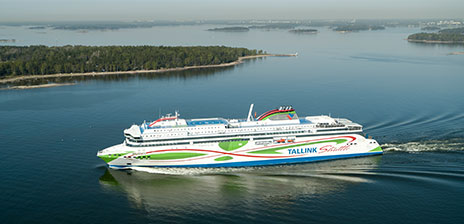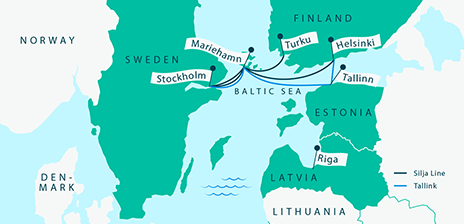Emissions surcharge from 2024
The EU Emissions Trading System (EU ETS) to include shipping from 2024 – impact on Tallink Grupp customers
| Route | One-way(€/person) | Round trip (€/person) | Cruise (€/person) |
|---|---|---|---|
| Helsinki-Tallinn | 0,9 € | 1,8 € | 3,8 € (22h) |
| Tallinn–Stockholm | 2,5 € | 2,5 € | 5 € |
| Helsinki–Stockholm | 1,4 € | 2,8 € | 2,8 € |
| Turku–Stockholm | 0,9 € | 1,8 € | 1,8 € |
| Turku–Kapellskär | 0,9 € | 1,8 € | 1,8 € |
| Helsinki-Tallinn Day Cruise & 5h cruise | - | - | 1,8 € |
Helsinki/Turku - Åland routes are currently free of charge.
There is no additional fee for children under 5 years old.
From 03 April until 19 June for cruise ship bookings, there is no additional fee for children under 11 years old.
As the price of the emissions allowances/quota will fluctuate on the market as a result of fluctuating demand, the Emissions surcharge will also reflect this fluctuation and will change over time.
What is the EU ETS?
Established in 2005, the EU ETS was the first emissions trading system in the world and remains the largest greenhouse gas emissions trading system across multiple countries and multiple sectors. It is a cornerstone of the EU's policy to combat climate change and its key tool for reducing greenhouse gas emissions cost-effectively.
Until now, shipping was not included among the sectors that the ETS covers and thus shipping companies did not have to pay for their CO2 emissions.
However, while maritime transport plays an essential role in the EU economy and is one of the most energy-efficient modes of transport, it is also a large and growing source of greenhouse gas emissions. At EU level, maritime transport is a substantial CO2 emitter, representing 3 to 4% of the EU’s total CO2 emissions, or over 144 million tonnes of CO2 in 2019.
To ensure that the maritime transport sector contributes to the EU’s increased climate ambition, the European Commission proposed to extend the scope of the EU's Emissions Trading System to cover CO2 emissions from large ships (above 5000 gross tonnage), regardless of the flag they fly. This extension has now been confirmed and from 2024 onwards the shipping industry is also covered by the ETS. The extension will include all emissions from ships calling at an EU port for voyages within the EU (intra-EU) as well as 50% of the emissions from voyages starting or ending outside of the EU (extra-EU voyages), and all emissions that occur when ships are at berth in EU ports.
How does the EU ETS work?
The EU ETS is a ‘cap and trade’ scheme where a limit (the cap) is placed on the amount to emit specified pollutants and obliges us as a company to hold an allowance for each tonne of CO2or other carbon equivalent gases we emit. The money from the sales of allowances will be used for EU’s green fund.
The EU ETS will in the start phase cover CO2 and eventually incorporate also nitrous oxides, soot and methane emissions – these will be included in the ETS scope using a certain calculation method.
There will be no set price list for these emission allowances – instead, the price will be defined by supply and demand on the market. As the supply side of these emission allowances will gradually be reduced to support the 2050 goal of net zero emissions, emission allowances will be increasingly costly, putting an even higher pressure on shipping companies to accelerate efforts to reduce their environmental footprint.
As for the scope of EU ETS, the new legislation will include 100% of emissions for voyages within the EU, 50% of the emissions from voyages starting or ending outside of the EU, and all emissions that occur when ships are at berth in EU ports.
To allow for a smooth transition to ETS, shipping companies will, during an initial phase-in period, purchase allowances for a portion of their total emissions; 40% in 2024, 70% in 2025 and eventually reaching 100% in 2026.
What has Tallink Grupp done to reduce emissions to date?
Tallink Grupp has been working on reducing our fleet’s total emissions since the early 2000’s. From operating ships that use fuels with lower sulphur content or building new ships which use alternatives to traditional fuels such as LNG, increasing our vessels’ energy efficiency, thus reducing their fuel consumption and emissions, Tallink has been putting in a concerted effort into reducing our emissions for well over a decade and a half.
Since we started monitoring our ships’ CO2 emissions in greater detail already back in 2009, we have, through the many steps taken, reduced our vessels’ carbon emissions in absolute terms already by more than 51%. The greatest impact has been the addition of the two LNG-fuelled vessels Megastar and MyStar to our fleet, but a significant positive impact has also been achieved through plugging our vessels into shore power, so they don’t have to burn fuel for energy during longer port stays, as well as several other energy efficiency increasing projects, technologies and solutions.
Tallink has committed itself to increasing the company’s vessels’ energy efficiency by at least 2% per year and to reducing its CO2 emissions also at least by 2% per year. These are realistic targets, helping us get closer to the globally set decarbonisation goals, and enabling us all to also pay less for our emissions as we go forward.
To benefit from the technological solutions and expertise available globally and across industries for tackling energy efficiency and emissions issues, Tallink has recently joined the Energy Efficiency Movement established by global technology giant ABB: energyefficiencymovement.com
What is the impact of the EU ETS on our customers?
As shipping companies will need to purchase emissions allowances to cover the emissions created with journeys from 1 January 2024 onwards, while at the same time also making significant investments into technologies and fuels that enable us to reduce the emissions, it is clear that the shipping companies alone cannot absorb all the costs involved and some of the costs will have to be passed on to our customers.
So, as our bookings open for 2024 sailings on 13 June 2023, we will introduce a new surcharge from this date on all bookings made into 2024. The new Emissions surcharge will at first be introduced for all passenger bookings made into 2024, and from autumn 2023 onwards a surcharge will also be introduced for the company’s cargo customers.
More details on the EU ETS can be found on the EU Commission website.








